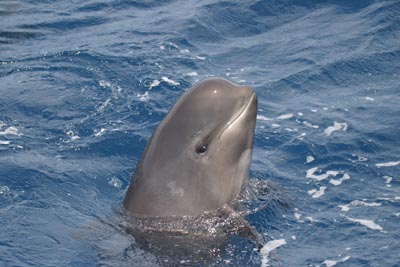Flame retardant pollutants which are toxic to wildlife and humans, have been analyzed in dolphins from the Spanish coast. This study by the CSIC, Loro Parque Foundation, CEPSA and CIRCE has analyzed samples of 67 dolphins.
 A study published at Environmental Pollution magazine shows that three dolphin species from the Strait of Gibraltar and the Gulf of Cadiz accumulate in their bodies flame retardant pollutants, both the classical PBDEs, which are already prohibited, and the alternative flame retardants, dechloranes.
A study published at Environmental Pollution magazine shows that three dolphin species from the Strait of Gibraltar and the Gulf of Cadiz accumulate in their bodies flame retardant pollutants, both the classical PBDEs, which are already prohibited, and the alternative flame retardants, dechloranes.
Flame retardants are compounds widely used in the industry. They are added to all kinds of goods, such as clothing, electronics devices, furniture and broad tapestry, in order to reduce the risk of fire. It has been demonstrated that they remain for a long time in the environment, accumulate in the organism and may have toxic effects on wildlife and humans.
This work, led by the Institute of Environmental Assessment and Water Research Studies (IDAEA) of the Spanish National Research Council (CSIC), has counted on the participation of scientists at the Doñana Biological Station (EBD-CSIC), and CIRCE (Conservation Information and Research on Cetaceans).
The study has been developed in the frame of FLAME, ECOCET and Consolider SCARCE projects, and has been funded by Loro Parque Fundación, CEPSA and the formerSpanish Ministry of Science and Innovation.
Accumulation and biomagnification of this pollutants
Scientists have shown in the study that three dolphin species, short-beaked common dolphin (Delphinus delphis), bottlenose dolphin (Tursiops truncatus) and long-finned pilot whale (Globicephala melas), which have different geographical distributions and diets, accumulate and biaomagnificate flame retardants.
The work demonstrates that the cetaceans that are in the highest level of the food chain, accumulate bigger amounts of these pollutants. Ethel Eljarrat, scientist from the CSIC says: “biomagnification means that the higher up the food chain, the bigger concentration of toxic in the organisms, because the animals are eating and accumulating the pollutants contained in their preys. The most interesting thing is that both, PBDEs and also alternative flame retardants, dechloranes, are biomagnified”.
Dolphins studied in this work are at different levels of the food chain. The bottlenose dolphin, at the highest position, has the biggest concentration of these pollutants.
“Near the 20% of the samples had higher values than the ones associated with endocrine disruption in grey seals”, says Renaud de Stephanis, co-author and scientists of CIRCE. "That means that these pollutants are a severe problem for the animals which are at the highest trophic levels, like the dolphins and human beings”.
The study also demonstrates that, although PBDEs were forbidden in 2004, they still remain in the environment and the alternative dechloranes are as persistent as the PBDEs. Besides, although their toxic effects are not known, some research suggests that dechloranes may cause endocrine disruption and genotoxicity.
Article:
E. Barón, J. Giménez, P. Verborgh, P. Gauffier, R. De Stephanis, E. Eljarrat, D. Barceló. Bioaccumulation and biomagnification of classical flame retardants, related halogenated natural compounds and alternative flame retardants in three delphinids from Southern European waters. Environmental Pollution, Volume 203, August 2015 (on-line) doi:10.1016/j.envpol.2015.03.041
FLAME Project: https://flameproject.wordpress.com
Consolider SCARCE Project: http://www.scarceconsolider.es
